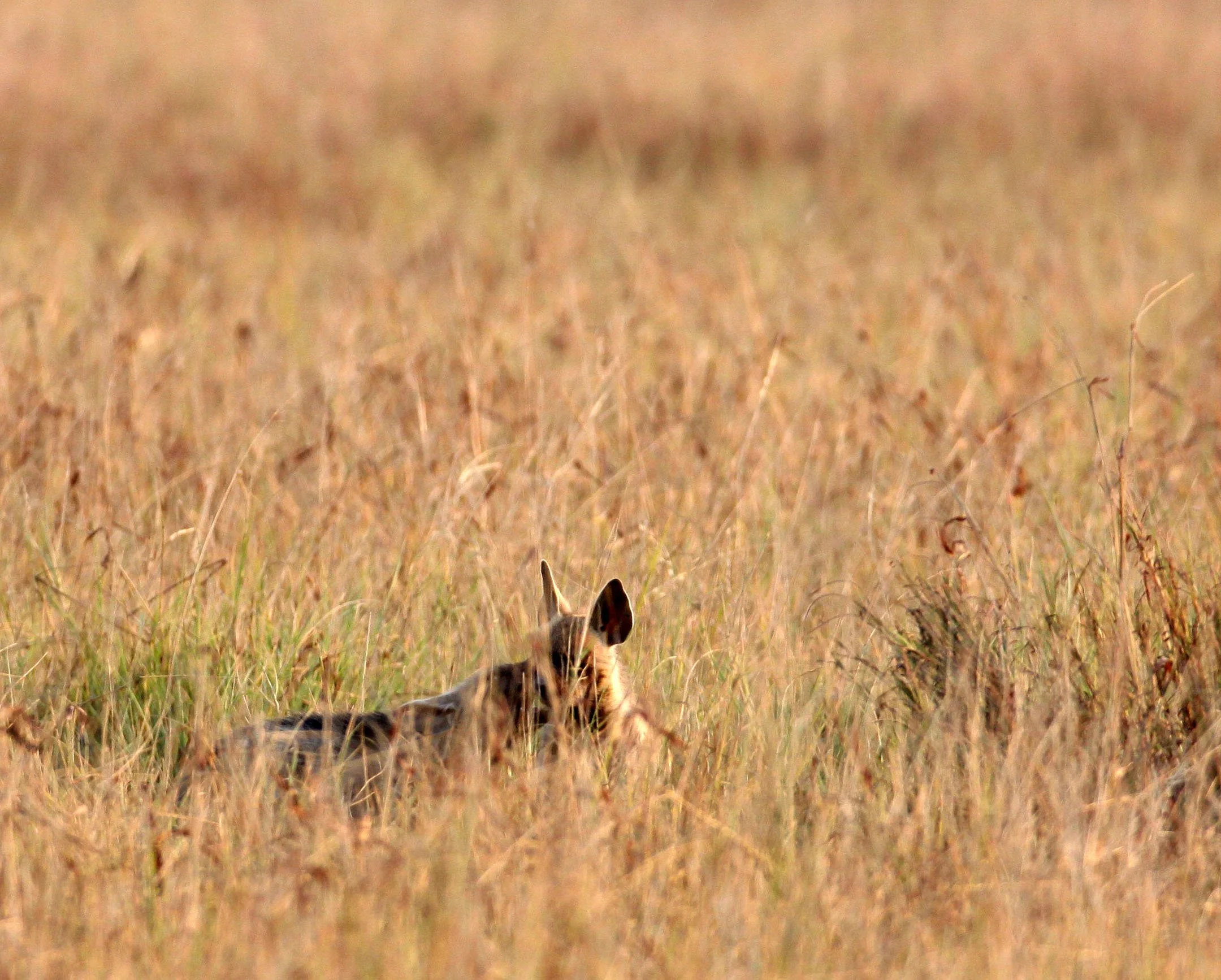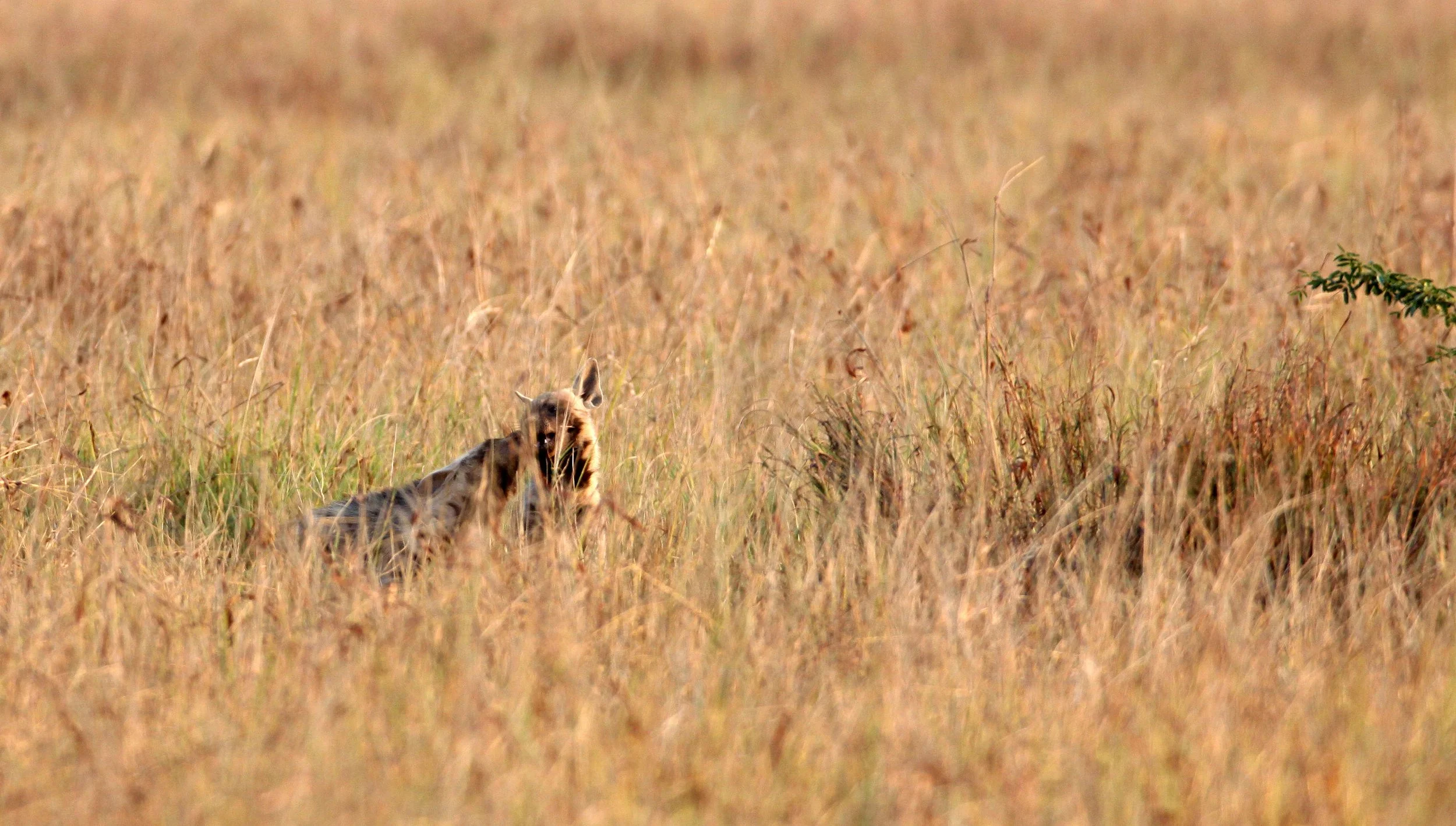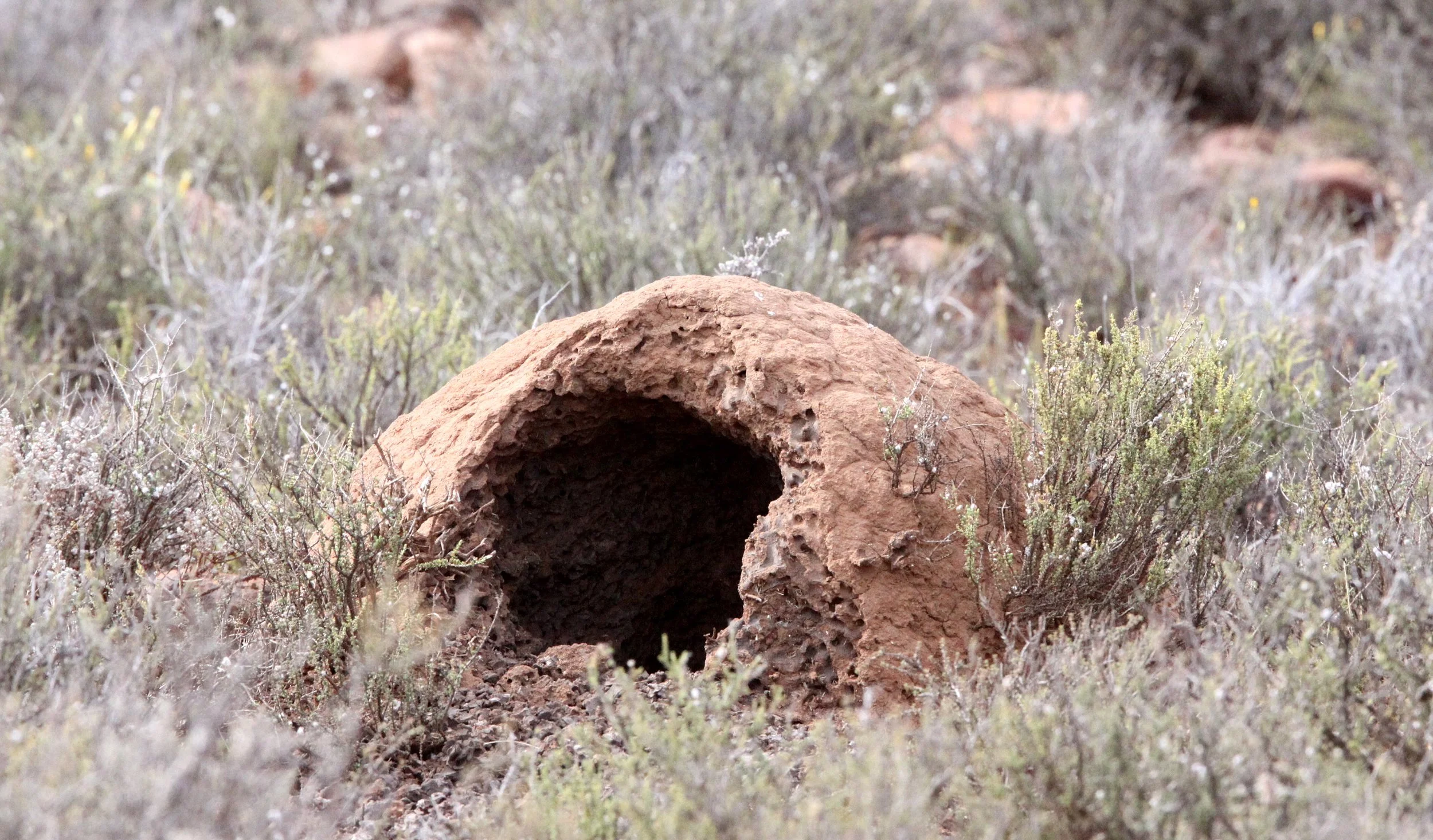
Hyaenidae range
Hyenas, or Hyaenas, are feliform carnivoran mammals of the family Hyaenidae. With only four extant species (each in its own genus), it is the fifth-smallest family in the Carnivora and one of the smallest in the class Mammalia. Despite their low diversity, hyenas are unique and vital components of most African ecosystems.
Although phylogenetically closer to felines and viverrids, as part of suborder Feliformia, hyenas are behaviourally and morphologically similar to canids in several elements due to convergent evolution; both hyenas and canines are non-arboreal, cursorial hunters that catch prey with their teeth rather than claws. Both eat food quickly and may store it, and their calloused feet with large, blunt, nonretractable claws are adapted for running and making sharp turns. However, hyenas' grooming, scent marking, defecation habits, mating and parental behavior are consistent with the behavior of other feliforms.
Hyenas feature prominently in the folklore and mythology of human cultures that live alongside them. Hyenas are commonly viewed as frightening and worthy of contempt. In some cultures, hyenas are thought to influence people's spirits, rob graves, and steal livestock and children. Other cultures associate them with witchcraft, using their body parts in traditional African medicine.
Spotted Hyena (Crocuta crocuta)
The Spotted Hyena (Crocuta crocuta), also known as the laughing hyena, is a hyena species, currently classed as the sole extant member of the genus Crocuta, native to sub-Saharan Africa. It is listed as being of least concern by the IUCN on account of its widespread range and large numbers estimated between 27,000 and 47,000 individuals. The species is, however, experiencing declines outside of protected areas due to habitat loss and poaching. The species may have originated in Asia, and once ranged throughout Europe for at least one million years until the end of the Late Pleistocene. The spotted hyena is the largest known member of the Hyaenidae, and is further physically distinguished from other species by its vaguely bear-like build, its rounded ears, its less prominent mane, its spotted pelt, its more dual-purposed dentition, its fewer nipples and the presence of a pseudo-penis in the female. It is the only placental mammalian species where females lack an external vaginal opening, having a pseudo-penis instead.
The spotted hyena is the most social of the Carnivora in that it has the largest group sizes and most complex social behaviours. Its social organisation is unlike that of any other carnivore, bearing closer resemblance to that of cercopithecine primates (baboons and macaques) with respect to group size, hierarchical structure, and frequency of social interaction among both kin and unrelated group-mates. However, the social system of the spotted hyena is openly competitive rather than cooperative, with access to kills, mating opportunities and the time of dispersal for males depending on the ability to dominate other clan-members. Females provide only for their own cubs rather than assist each other, and males display no paternal care. Spotted hyena society is matriarchal; females are larger than males, and dominate them.
The spotted hyena is a highly successful animal, being the most common large carnivore in Africa. Its success is due in part to its adaptability and opportunism; it is primarily a hunter but may also scavenge, with the capacity to eat and digest skin, bone and other animal waste. In functional terms, the spotted hyena makes the most efficient use of animal matter of all African carnivores. The spotted hyena displays greater plasticity in its hunting and foraging behaviour than other African carnivores; it hunts alone, in small parties of 2–5 individuals or in large groups. During a hunt, spotted hyenas often run through ungulate herds in order to select an individual to attack. Once selected, their prey is chased over a long distance, often several kilometres, at speeds of up to 60 km/h.
The spotted hyena has a long history of interaction with humanity; depictions of the species exist from the Upper Paleolithic period, with carvings and paintings from the Lascaux and Chauvet Caves. The species has a largely negative reputation in both Western culture and African folklore. In the former, the species is mostly regarded as ugly and cowardly, while in the latter, it is viewed as greedy, gluttonous, stupid, and foolish, yet powerful and potentially dangerous. The majority of Western perceptions on the species can be found in the writings of Aristotle and Pliny the Elder, though in relatively unjudgmental form. Explicit, negative judgments occur in the Physiologus, where the animal is depicted as a hermaphrodite and grave-robber. The IUCN's hyena specialist group identifies the spotted hyena's negative reputation as detrimental to the species' continued survival, both in captivity and the wild.

Western Kenya
















Okavango, Botswana






Imfolozi NP, South Africa



































Kruger National Park, South Africa





















Okavango Delta, Botswana



















Queen Elizabeth NP, Uganda





Striped Hyena (Hyaena hyaena)
The Striped Hyena (Hyaena hyaena) is a species of hyena native to North and East Africa, the Middle East, the Caucasus, Central Asia and the Indian subcontinent. It is the only extant species in the genus Hyaena. It is listed by the IUCN as near-threatened, as the global population is estimated to be under 10,000 mature individuals which continues to experience deliberate and incidental persecution along with a decrease in its prey base such that it may come close to meeting a continuing decline of 10% over the next three generations. It is also the national animal of Lebanon.
It is the smallest of the bone-cracking hyenas and retains many primitive viverrid-like characteristics lost in larger species, having a smaller and less specialised skull. Though primarily a scavenger, large specimens have been known to kill their own prey, and attacks on humans have occurred in rare instances.[9] The striped hyena is a monogamous animal, with both males and females assisting one another in raising their cubs. A nocturnal animal, the striped hyena typically only emerges in complete darkness, and is quick to return to its lair before sunrise. Although it has a habit of feigning death when attacked, it has been known to stand its ground against larger predators in disputes over food.
The striped hyena features prominently in Middle Eastern and Asian folklore. In some areas, its body parts are considered magical, and are used as charms or talismans. It is mentioned in the Hebrew Bible, where it is referred to as tzebua or zevoa, though it is absent in some Bible translations into English. Ancient Greeks knew it as γλάνος (glános) and ύαινα (húaina) and were familiar with it from the Aegean coast of Asia Minor.

Gujarat India


















































Syrian Striped Hyena (Hyaena hyaena syriaca) Captive individuals in Shaumari Reserve, Jordan.



Aardwolf (Proteles cristata)
The Aardwolf (Proteles cristata) is an insectivorous species of hyena, native to East and Southern Africa. Its name means "earth-wolf" in Afrikaans and Dutch. It is also called maanhaar-jackal (Afrikaans for "mane-jackal"), termite-eating hyena[6] and civet hyena, based on its habit of secreting substances from its anal gland, a characteristic shared with the African civet.
Unlike many of its relatives in the order Carnivora, the aardwolf does not hunt large animals. It eats insects and their larvae, mainly termites; one aardwolf can lap up as many as 250,000 termites during a single night using its long, sticky tongue. The aardwolf's tongue has adapted to be tough enough to withstand the strong bite of termites.
The aardwolf lives in the shrublands of eastern and southern Africa – open lands covered with stunted trees and shrubs. It is nocturnal, resting in burrows during the day and emerging at night to seek food.
The aardwolf is generally classified with the hyena family Hyaenidae, though it was formerly placed in its own family Protelidae. Early on, scientists felt that it was merely mimicking the striped hyena, which subsequently led to the creation of Protelidae. Recent studies have suggested that the aardwolf probably diverged from other hyaenids early on; how early is still unclear, as the fossil record and genetic studies disagree by 10 million years.
The aardwolf is the only surviving species in the subfamily Protelinae. There is disagreement as to whether the species is monotypic, or can be divided into subspecies P. c. cristatus of Southern Africa and P. c. septentrionalis of East Africa.
A 2006 molecular analysis indicates that it is phylogenetically the most basal of the four extant hyaenidae species.
The generic name proteles comes from two words both of Greek origin, protos and teleos which combined means "complete in front" based on the fact that they have five toes on their front feet and four on the rear. The specific name, cristatus, comes from Latin and means "provided with a comb", relating to their mane.
The aardwolf resembles a very thin striped hyena, but with a more slender muzzle, black vertical stripes on a coat of yellowish fur, and a long, distinct mane down the midline of the neck and back. It also has one or two diagonal stripes down the fore- and hind-quarters, along with several stripes on its legs. The mane is raised during confrontations to make the aardwolf appear larger. It is missing the throat spot that others in the family have. Its lower leg (from the knee down) is all black, and its tail is bushy with a black tip.
As an aardwolf ages, it will normally lose some of its teeth, though this has little impact on its feeding habits due to the softness of the insects that it eats.
Aardwolves live in open, dry plains and bushland, avoiding mountainous areas. Due to their specific food requirements, they are only found in regions where termites of the family Hodotermitidae occur. Termites of this family depend on dead and withered grass and are most populous in heavily grazed grasslands and savannahs, including farmland. For most of the year, aardwolves spend time in shared territories consisting of up to a dozen dens, which are occupied for six weeks at a time.
There are two distinct populations: one in Southern Africa, and another in East and Northeast Africa. The species does not occur in the intermediary miombo forests. An adult pair, along with their most-recent offspring, occupies a territory of 1–4 km2 (0.39–1.54 sq mi).
Aardwolves are shy and nocturnal, sleeping in burrows by day. They will, on occasion during the winter, become diurnal feeders. This happens during the coldest periods as they then stay in at night to conserve heat.
They have often been mistaken for solitary animals. In fact, they live as monogamous pairs with their young. If their territory is infringed upon, they will chase the intruder up to 400 m (1,300 ft) or to the border. If the intruder is caught, which rarely happens, a fight will occur, which is accompanied by soft clucking, hoarse barking, and a type of roar. The majority of incursions occur during mating season, when they can occur once or twice per week. When food is scarce, the stringent territorial system may be abandoned and as many as three pairs may occupy a single territory.
The territory is marked by both sexes, as they both have developed anal glands from which they extrude a black substance that is smeared on rocks or grass stalks in 5-millimetre (0.20 in)-long streaks. Aardwolves also have scent glands on the forefoot and penile pad. They often mark near termite mounds within their territory every 20 minutes or so. If they are patrolling their territorial boundaries, the marking frequency increases drastically, to once every 50 m (160 ft). At this rate, an individual may mark 60 marks per hour, and upwards of 200 per night.
An aardwolf pair may have up to 10 dens, and numerous feces middens, within their territory. When they deposit excreta at their middens, they dig a small hole and cover it with sand. Their dens are usually abandoned aardvark, springhare, or porcupine dens, or on occasion they are crevices in rocks. They will also dig their own dens, or enlarge dens started by springhares. They typically will only use one or two dens at a time, rotating through all of their dens every six months. During the summer, they may rest outside their den during the night, and sleep underground during the heat of the day.
Aardwolves are not fast runners nor are they particularly adept at fighting off predators. Therefore, when threatened, the aardwolf may attempt to mislead its foe by doubling back on its tracks. If confronted, it may raise its mane in an attempt to appear more menacing. It also emits a foul-smelling liquid from its anal glands.
Aardwolf (Proteles cristata) Kimberly Desert South Africa













